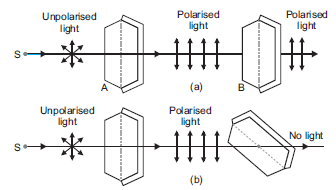Wave Optics
(a) Using the phenomenon of polarization, show how transverse nature of light can be demonstrated.
(b) Two Polaroid P1 and P2 are placed with their pass axes perpendicular to each other. Unpolarised light of intensity Io is incident on P1. A third Polaroid P3 is kept in between P1 and P2 such that its pass axis makes an angle of 30o with that of P1. Determine the intensity of light transmitted through P1, P2 and P3.
a)
i. Light from a source S is allowed to fall normally on the flat surface of a thin plate of a tourmaline crystal, cut parallel to its axis. Only a part of this light is transmitted through A.
ii. If now the plate A is rotated, the character of transmitted light remains unchanged.
iii. Now another similar plate B is placed at some distance from A such that the axis of B is parallel to that of A.
iv. If the light transmitted through A is passed through B, the light is almost completely transmitted through B and no change is observed in the light coming out of B. 
v. If now the crystal A is kept fixed and B is gradually rotated in its own plane, the intensity of light emerging out of B decreases and becomes zero when the axis of B is perpendicular to that of A.
vi. If B is further rotated, the intensity begins to increase and becomes maximum when the axes of A and B are again parallel. Thus, we see that the intensity of light transmitted through B is maximum when axes of A and B are parallel and minimum when they are at right angles.
From this experiment, it is obvious that light waves are transverse and not longitudinal; because, if they were longitudinal, the rotation of crystal B would not produce any change in the intensity of light.
Intensity of light transmitted through P1 = Io/2
Intensity of light transmitted through P3 = ( Io / 2) cos 2 30o = 3 Io / 8
Intensity of light transmitted through P2 = 3/8 Io cos2 60o = 3/32 Io
Sponsor Area
Some More Questions From Wave Optics Chapter
What is the shape of the wavefront in each of the following cases:
Light diverging from a point source.
What is the shape of the wavefront in each of the following cases:
Light emerging out of a convex lens when a point source is placed at its focus.
What is the shape of the wavefront in each of the following cases:
The portion of the wavefront of light from a distant star intercepted by the Earth.
Is the speed of light in glass independent of the colour of light? If not, which of the two colours red and violet travels slower in a glass prism?
Mock Test Series
Sponsor Area
NCERT Book Store
NCERT Sample Papers
Sponsor Area